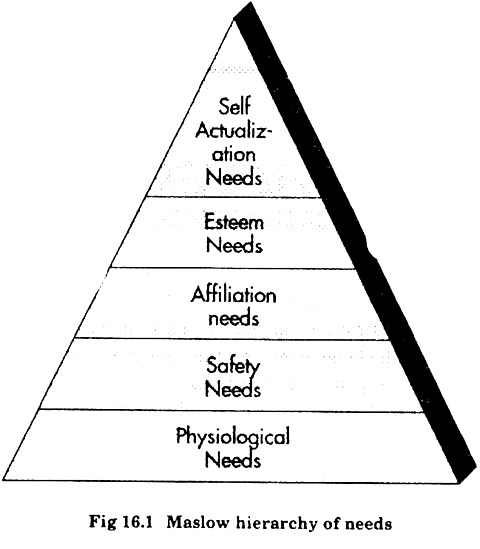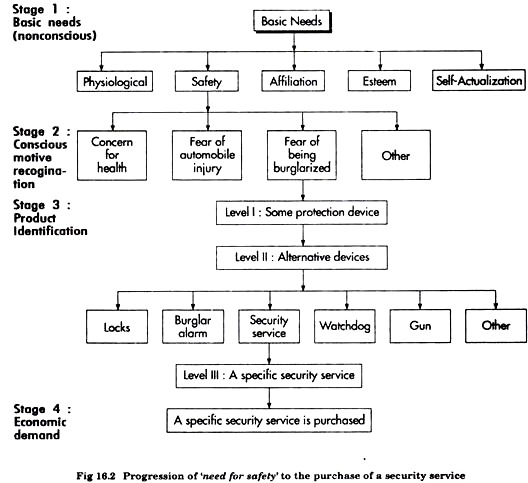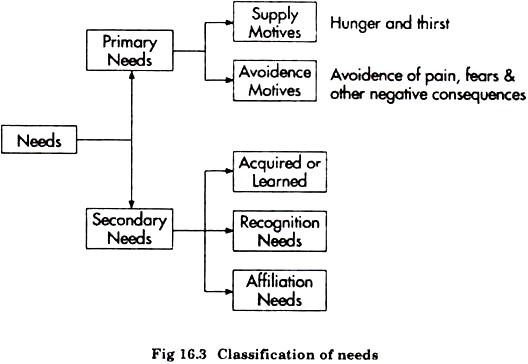This article throws light upon the two key issues relating to consumer’s needs. The key issues are:- 1. The Number and the Nature of Basic Needs 2. The Intensity of Motivated Behaviour.
Key Issue # 1. The Number and the Nature of Basic Needs:
There is no universal agreement regarding the number and nature of basic needs or internal need states. Abraham Maslow has described human beings as wanting animals and suggested that human needs are insoluble. As quickly as one set of needs is satisfied, another set arises. Maslow postulated that human beings have a hierarchy of needs, and that lower level needs must be largely satisfied before higher level needs become salient.
The hierarchy, arranged from lower to higher, is summarized below (Fig. 16.1):
a. Physiological Needs:
ADVERTISEMENTS:
If the organism is to survive, physiological needs must be met. Essentially, these biological needs are hunger thirst, waste elimination, and so on.
b. Safety Needs:
Included among the safety needs are security, protection, avoidance of pain, and order and structure in the environment.
c. Affiliation Needs:
ADVERTISEMENTS:
These are social needs. Human beings need warm and satisfying relationships with other people—needs for association and affection.
d. Esteem Needs:
These are needs for recognition and self-respect.
There are two kinds of esteem needs:
(i) Achievement personal adequacy in dealing with the environment and other people, confidence, and independence; and
(ii) Reputation, respect, attention and appreciation.
e. Self Actualisation Needs:
These are needs for self fulfillment; the need to become relatively independent from environmental demands and to develop all of one’s abilities. At a primitive level, where no needs are being met, physiological needs dominate human behaviour.
ADVERTISEMENTS:
The other needs remain un-recognised until physiological needs are largely met. Once physiological need’s have been largely satisfied and no longer exert an influence on behaviour, the next higher order needs, those of safety, emerge. This level of need satisfaction then becomes predominant and remains so until it is largely fulfilled. The same progression follows down through the hierarchy.
When need at a particular level are frustrated, or only partially satisfied, they persist as an influence on the individual’s motivational patterns. Unfortunately, the circumstances of human existence often prevent the satisfaction of all lower order needs, so relatively few people ever become self actualizes, although most of us engage in some self actualizing behaviour.
A key point in Maslow’s theory is that our needs are never satisfied. As needs at a particular level in the hierarchy are satisfied, other higher order needs emerge to take their place. According to this theory, marketing does not create needs.
Diverse and emerging needs are a unique human experience. Marketing may contribute to the creation of wants by portraying products as instrumentalities that can be used to satisfy basic needs. However, material products and services only partially satisfy most human need states, so human motivational patterns remain remarkably persistent.
Berelson and stenier have given a list of primary and secondary human needs. The primary needs are physiological and is based on biological functioning of every human being The secondary needs are those which are acquired or learned and are not necessary for the basic biological functioning of an individual. (Fig. 16.3).
Following inferences may be drawn:
(i) Unsatisfied needs are motivators
ADVERTISEMENTS:
(ii) Much of the human behaviour is motivated by sub conscious and unconscious needs.
(iii) Several needs operate simultaneously to cause given behaviour.
Key Issue # 2. The Intensity of Motivated Behaviour:
The second issue relating to motivation lies in the recognition that some motives require more energy to be expended in their service than others. We may spend a great deal of time and energy to satisfy some of our motives, while denoting relatively little time and effort to satisfy others. In addition, people differ dramatically in the effort they put forth to achieve what appears to be the same motive.
For example, let us assume that two people of similar ability and means express desires to become medical doctors. One, through self-discipline, hard work and long hours of study, eventually is graduated as an M.B.B.S.
ADVERTISEMENTS:
The other unwilling to make the personal sacrifices or put forth the effort required, drops out of the programme. In comparing their behaviours, most people would agree that the student who completed the programme was more highly motivated toward becoming a doctor than the one who die not.
In order to explain the differences in intensity that characterise motivated behaviour, cognitive psychologists often invoke the concept of central and peripheral needs:
i. Central Needs, are those needs closely related to our sense of identify and survival. In our definition of motivation, they are termed basic needs state and include psychological, safety, affiliation, esteem and self-actualizing needs.
ii. Peripheral Needs, sometimes referred to as instrumental needs or wants, consist of the preferences one has for alternative means of satisfying central needs. For example, a minimum amount of liquid is required for survival (a central need).
A variety of liquids will satisfy this minimum requirement—water, bear, tea, coffee, fruit juices and so on. The individual’s preference order for each of these alternative liquids represents a personal order of instrumental needs or wants. Even though one liquid is preferred, if it is not available, another will suffice.
Similarly, from a psychological stand point, status may represent a control need. Status may be satisfied in a variety of ways—money, housing, excellence in any variety of activities, becoming a member of a profession, holding office in an organisation, and so on.
ADVERTISEMENTS:
An individual’s particular order of preference for these alternatives represents a hierarchy of Peripheral needs and, if the preferred alternative is unobtainable, the next alternative is acceptable. although perhaps not as satisfying.


